Ten or Maybe Even More Things You Don’t Know about Meatballs

There are a million meatball recipes available online. I’m sure most of them are pretty yummy, but I’m not here to tout the best meatball recipe. I’m here to tell you what you probably don’t know about meatballs and the important techniques you can apply to any meatball recipe.
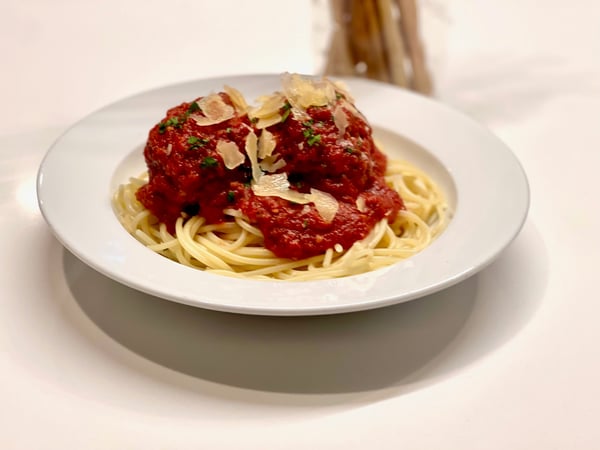 I think you may be very surprised to hear the answers to these questions:
I think you may be very surprised to hear the answers to these questions:
- Does it matter what order I put the ingredients in when preparing the meatball?
- What is the missing ingredient in most meatball recipes?
- Do bread crumbs really hold meatballs together?
- What is the secret to a juicy and tender meatball?
- What do the eggs do in a meatball recipe?
- What is the best way to cook a meatball?
- How do I get the most flavor in my meatballs?
Read on if you want to become a meatball master.
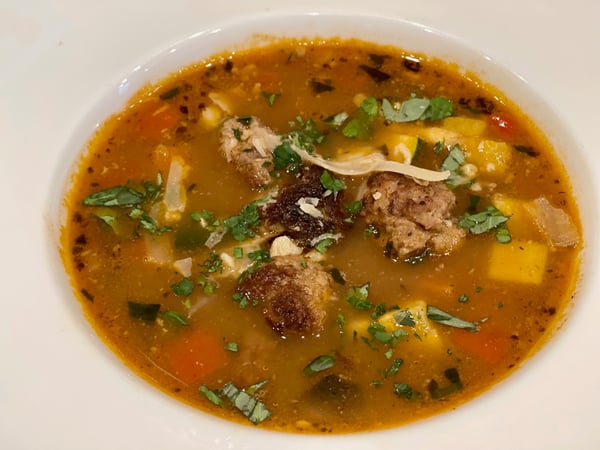 Does it matter what order I put the ingredients in when preparing the meatball mix?
Does it matter what order I put the ingredients in when preparing the meatball mix?
Just follow me for a minute here while I digress. What’s the difference in texture between a hot dog and an Italian sausage? Think about it for a minute… a hot dog is very smooth, light and airy and Italian sausage is coarse and heavy. A hot dog is an emulsified sausage and an Italian sausage is not emulsified. An emulsified sausage like a hot dog starts with a different coarseness of meat but what really gives its light texture is the addition of liquid. Emulsification happens when we combine liquid and fat in a way that binds them.
If you think about it, a meatball is really a very simple version of a sausage. To me, the perfect texture for a meatball wouldn’t be like a hot dog but not exactly as dense and coarse as an Italian sausage - it’s ideally somewhere in between. I want my meatball to have both some lightness and some denseness. In the case of a meatball, the liquid we add and how we add it can transform your meatball.
If you just dump all your meatball ingredients together and lightly mix them, you are missing an opportunity. I like to take my ground meat and start by mixing in a little water or a very flavorful stock as the first step. If your first step is adding liquid to the ground meat followed by a thorough mixing, you create an emulsification. You have entangled the fat and the liquid in the meatball together which changes the texture of the meatball completely. The meatball will still have its meaty texture, but it will be a lighter and less dense version of itself.
What is the missing ingredient in most meatball recipes?
You guessed it, a little water or stock. You can take any meatball recipe and add a tablespoon or two of water or stock as a first step and see how it lightens your recipe. I like to add water or stock as a first ingredient and mix it thoroughly and then add the egg and mix it in the same way. If you are not using water or stock, you can add your eggs prior to all other ingredients and accomplish a very similar result.
Do the bread crumbs really hold meatballs together?
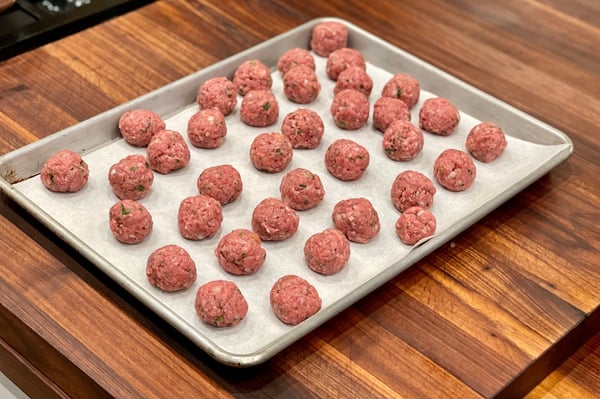 No! Bread crumbs and other fillers have nothing to do with holding meatballs together. This is a common misconception. Think of it this way: do you need to put bread crumbs in your hamburger so that it stays together? Of course not. Ground meat needs no assistance in holding its form when cooked. Bread crumbs are there to keep the fat in the meatballs. Yes, you heard me right, we want the fat to stay in our meatballs and not leach out. Why do we want fat in our meatballs? Texture, what we love about fat is not so much the flavor but the juicy mouthfeel. A small amount of breadcrumbs, no more than 1/4 cup of fine crumbs per pound of meat, hold in the juices. Adding, more bread crumbs makes for a heavy and dense meatball so keep the bread crumbs to a minimum.
No! Bread crumbs and other fillers have nothing to do with holding meatballs together. This is a common misconception. Think of it this way: do you need to put bread crumbs in your hamburger so that it stays together? Of course not. Ground meat needs no assistance in holding its form when cooked. Bread crumbs are there to keep the fat in the meatballs. Yes, you heard me right, we want the fat to stay in our meatballs and not leach out. Why do we want fat in our meatballs? Texture, what we love about fat is not so much the flavor but the juicy mouthfeel. A small amount of breadcrumbs, no more than 1/4 cup of fine crumbs per pound of meat, hold in the juices. Adding, more bread crumbs makes for a heavy and dense meatball so keep the bread crumbs to a minimum.
*I recommend ground meat that has at least 20% fat to create the right texture and taste.
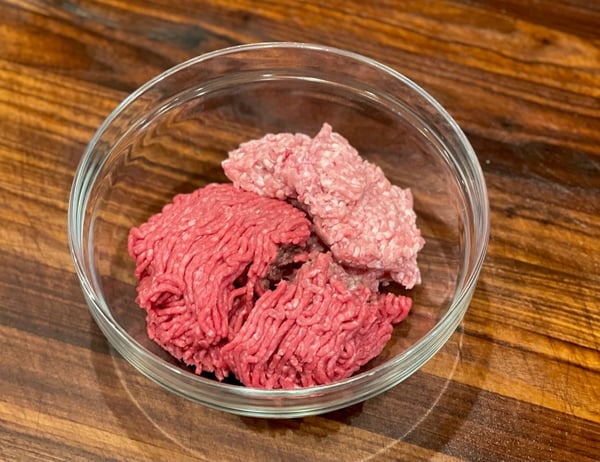 What do the eggs do in a meatball recipe?
What do the eggs do in a meatball recipe?
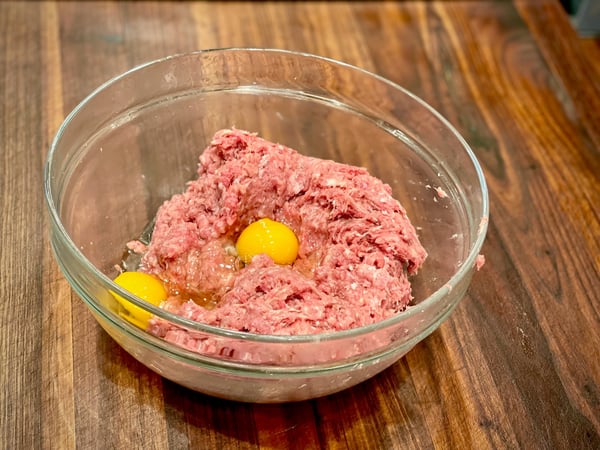 I’ve heard other bloggers say eggs are there to hold the meatball together in one breath and in the next say, “you can make your meatballs without the eggs.” What? If there are recipes that don’t include eggs, and recipes that do, you can certainly ascertain that they are not essential in holding the meatball together. I’m not saying eggs don’t have a binding property, it just isn’t what makes them worth adding to the meatball.
I’ve heard other bloggers say eggs are there to hold the meatball together in one breath and in the next say, “you can make your meatballs without the eggs.” What? If there are recipes that don’t include eggs, and recipes that do, you can certainly ascertain that they are not essential in holding the meatball together. I’m not saying eggs don’t have a binding property, it just isn’t what makes them worth adding to the meatball.
What are the eggs really doing that’s so great? Eggs, especially egg yolks, add moisture, which is a benefit in itself, but they also add fat and protein. When you add bread crumbs, which add carbohydrates, and you add eggs, which add protein, you create amazing browning opportunities. If cooked properly (we will get to cooking in a minute) your meatballs will brown very quickly and intensely with the addition of eggs and bread crumbs. Why does browning matter? Read on.
*Try using two egg yolks instead of one whole egg in your meatball recipe if your recipe calls for one egg. Try using three egg yolks if your recipe calls for two eggs. See how much more intensely your meatball browns.
How do I get the most flavor in my meatballs?
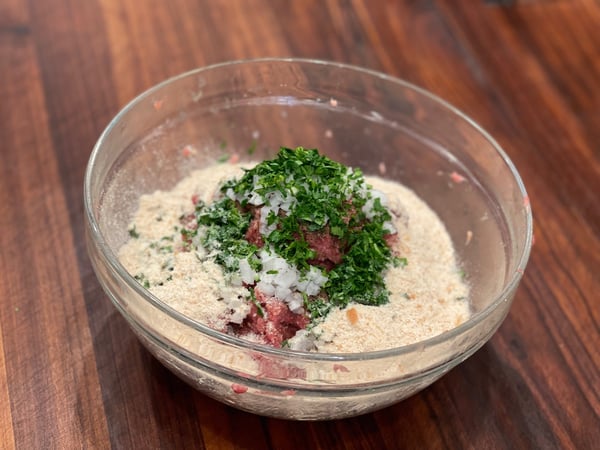 Finely minced onions, garlic or any other fresh ingredient
Finely minced onions, garlic or any other fresh ingredient
Most recipes I see sauté the onion and garlic, if using it, prior to adding it the meatballs. Sautéing the vegetables isn’t a bad thing to do, it just misses some flavor opportunities. I think modern recipes have converted to sautéing the aromatic ingredients to correct the issue of cooks not chopping the ingredients finely. Have you ever had a potsticker or a won ton? If you have, I am sure you would agree the fillings are incredibly flavorful. They get this flavor because these meat fillings always use raw ingredients, minced very finely. Sautéing subdues the flavor of the ingredients.
Anything less than a fine mince doesn’t disperse the ingredients properly. Meatballs are small, relatively speaking, so you don’t want to bite into a big piece of green pepper in your meatball because all you will taste is green pepper. Remember my comment about meatballs being a simple version of a sausage? Ingredients are very evenly distributed in a sausage, do the same for your meatball so that every bite is seasoned.
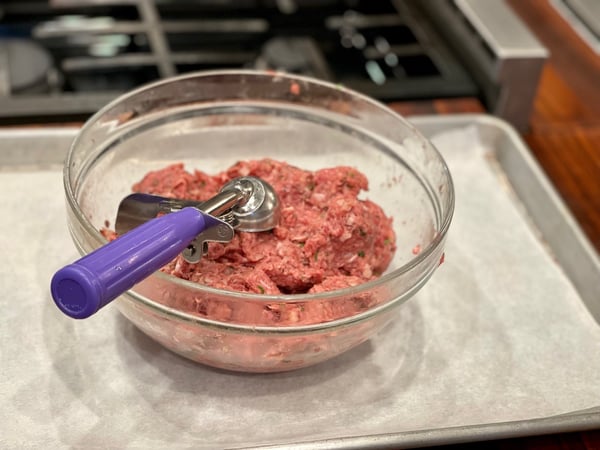 Big chunks or even a small dice of uncooked or cooked vegetables in your meatballs can inhibit the meatballs from holding their shape. Finely mince everything not only for flavor but so the meatballs hold their shape!
Big chunks or even a small dice of uncooked or cooked vegetables in your meatballs can inhibit the meatballs from holding their shape. Finely mince everything not only for flavor but so the meatballs hold their shape!
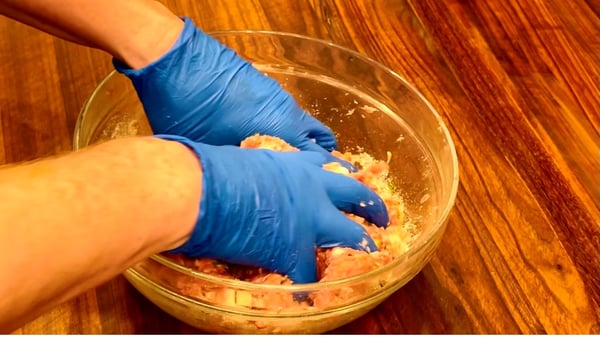 Mix the meatballs very well
Mix the meatballs very well
I have heard other bloggers say "don’t overmix the meatballs". Well, this isn't a cake, and in my opinion it is better to make sure all the seasonings are well distributed than to worry about overmixing. The only thing that can happen with a lot of mixing is that the grain of the meat can break down and get smoother but even with lots of mixing you will retain that nice meatball grain. I say don’t worry about overmixing, worry about making sure the ingredients and seasonings are well dispersed.
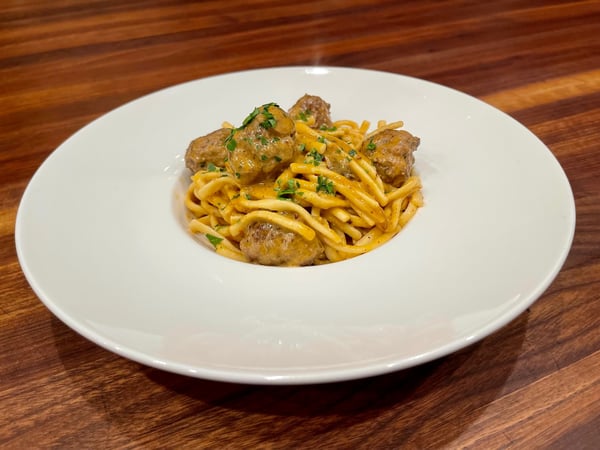 Kick up the Umami
Kick up the Umami
Umami is the 5th flavor. We discuss Umami in our Flavor Dynamics class but in a nutshell, it is what I consider an earthy flavor. Meat, mushrooms, anchovies, tomatoes, bread, Parmesan cheese are all Umami bombs. Well, isn’t it funny these are all common ingredients in meatballs? Punch up the flavor of your meatball by adding one or more of these ingredients to your meatballs. Kicking up the Umami brings the meatiness out in your meatball.
Salt the meatballs
I say this in almost every class I teach, “the fattier the food, the more salt it needs.” Fatty foods like meatballs just lay flat without enough salt. A potato chip without a generous amount of salt isn’t much of a chip. A fine sea salt disperses easily, so if you have it, use it here and season generously.
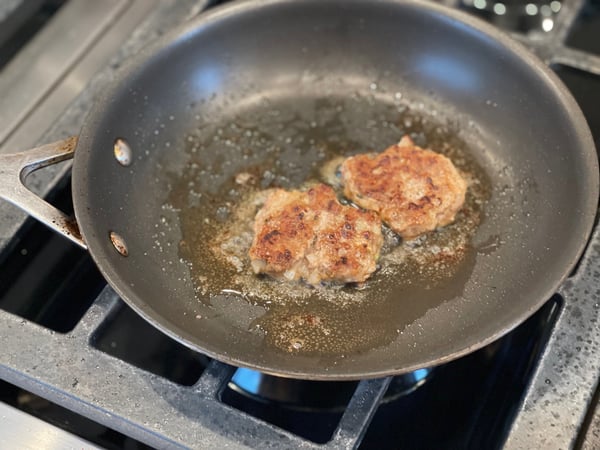 Make sure to taste the meatball mixture
Make sure to taste the meatball mixture
For most people, the idea of tasting a bite of raw meatball mix isn’t something we would look forward to. Even if you had no problem tasting a spoonful of raw meatball mix, it probably wouldn’t give a true sense of what your meatball will ultimately taste like. I like to heat up a small skillet and make a tiny little hamburger patty of meatball mix and cook it. This may be the most important step in ensuring a tasty meatball, taste it before you serve it and adjust seasoning as needed.
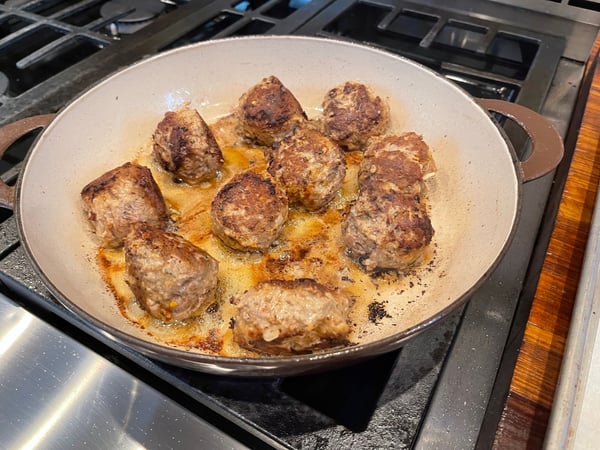 Browning
Browning
The browning process offers an immense amount of flavor to the meatball. Don’t be blasé about browning those meatballs. Read on for more on browning.
What is the best way to cook a meatball?
Let’s start with how not to cook your meatball. The easiest way to cook meatballs is to put them on a sheet pan and bake them in the oven. This is also the easiest way to overcook your meatballs. It takes a long time in the oven for the meatballs to brown, in fact they don’t usually brown until the meatballs are completely cooked. As I mentioned earlier, I like to avoid cooking the meatballs all the way through during the browning phase. I want them to brown as quickly as possible and cook them as little as possible during the browning phase. Sometimes recipes will indicate that you should broil the meatballs, this will certainly brown your meatballs nicely but the intense heat of the broiler, generally 550 degrees, can also assist in drying out your meatballs. When you brown with too intense of a heat, the outside of the meatball will shrink quickly and start to squeeze out the juices, it’s a little like putting a tourniquet on your meatball except that the juices are flowing out.
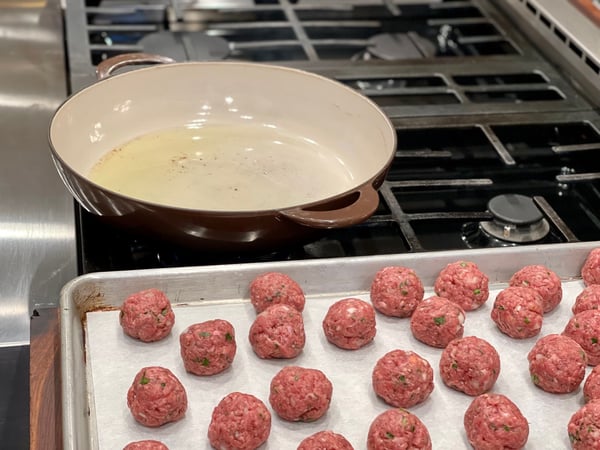 So how do you cook meatballs? Break out your best heavy duty sauté pan, at least 10 inches in circumference. Heat your pan to between 425-450 degrees, this is the perfect medium high temperature for sautéing most everything. Do yourself a favor and buy a 10-dollar surface thermometer, and stick that in your pan while you’re heating the pan so you know exactly when it is the proper temperature. Once the pan is hot, add a layer of grapeseed oil to coat the pan and start adding the meatballs. Keep plenty of space between each meatball, it helps immensely in browning to not overcrowd your pan.
So how do you cook meatballs? Break out your best heavy duty sauté pan, at least 10 inches in circumference. Heat your pan to between 425-450 degrees, this is the perfect medium high temperature for sautéing most everything. Do yourself a favor and buy a 10-dollar surface thermometer, and stick that in your pan while you’re heating the pan so you know exactly when it is the proper temperature. Once the pan is hot, add a layer of grapeseed oil to coat the pan and start adding the meatballs. Keep plenty of space between each meatball, it helps immensely in browning to not overcrowd your pan.
You will find it almost difficult to keep up with how quickly they will brown. As soon as one side browns turn it to another side, moving the meatballs around until they are nicely brown on most of the surface. Take them off the heat and set them aside until it’s time to marry them to your sauce of choice. No need to worry if they are cooked enough, only worry that you are overcooking them. Again, we don’t want to cook them during this phase, just brown them as quickly and deeply as we can. We will cook them in the sauce later.
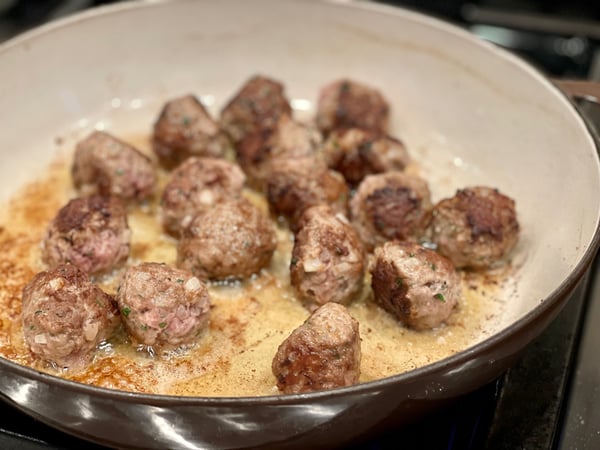 What is the secret to a juicy and tender meatball?
What is the secret to a juicy and tender meatball?
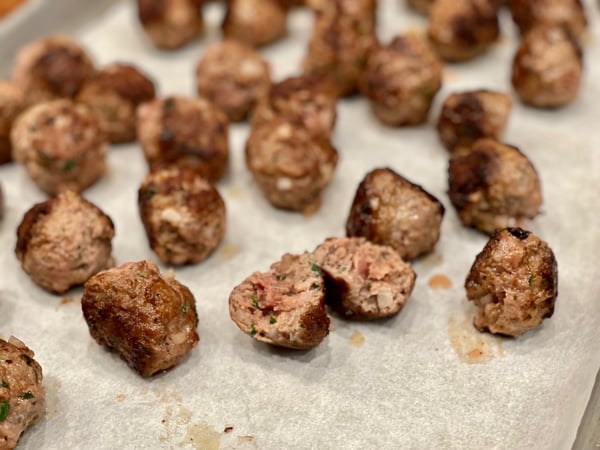 Don't overcook your meatballs! Most recipes instruct us to bake the meatballs until they are completely cooked. Next, we are to let them simmer away in some kind of sauce for hours. It should be no surprise that your meatball is going to be completely overcooked and dry by the time you eat it. The simple solution is not to cook them completely as a first step, just brown them as we discussed above. Brown your meatballs and then simmer them or bake them in their sauce at very low temperature for 20 to 30 minutes. This low temperature helps to keep the meatballs moist while ensuring they have adequate time to be infused with the sauce.
Don't overcook your meatballs! Most recipes instruct us to bake the meatballs until they are completely cooked. Next, we are to let them simmer away in some kind of sauce for hours. It should be no surprise that your meatball is going to be completely overcooked and dry by the time you eat it. The simple solution is not to cook them completely as a first step, just brown them as we discussed above. Brown your meatballs and then simmer them or bake them in their sauce at very low temperature for 20 to 30 minutes. This low temperature helps to keep the meatballs moist while ensuring they have adequate time to be infused with the sauce.
If you want to learn how to make a different type of meatball, don't miss our Hands-On Greek Islands class which features Lamb and Cumin Meatballs with Tomato Sauce. But hurry, we only have 2 spots left in this class on Friday, February 17 at 6pm at Lincoln Square! We're offering it again on Saturday, March 4 at 6pm so snag a spot now.

